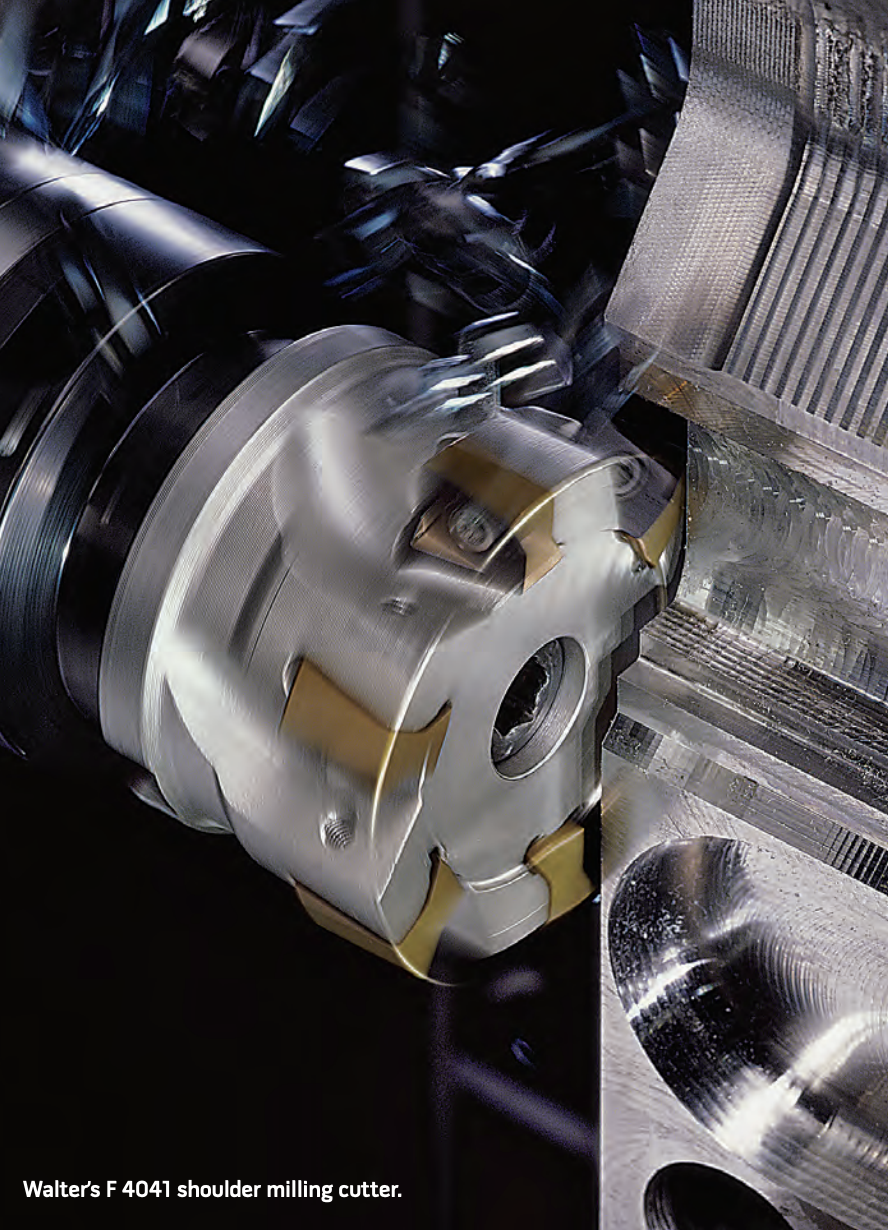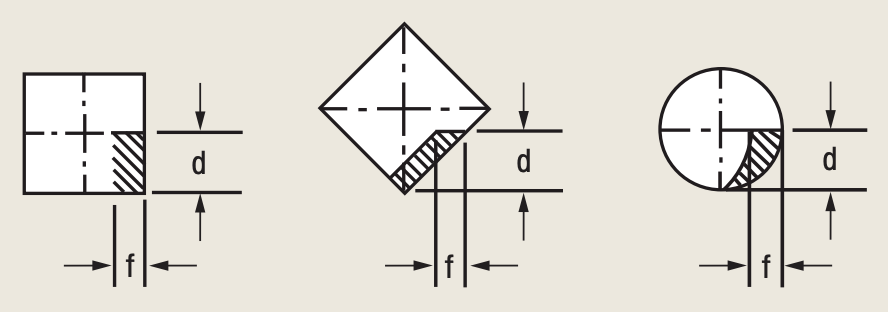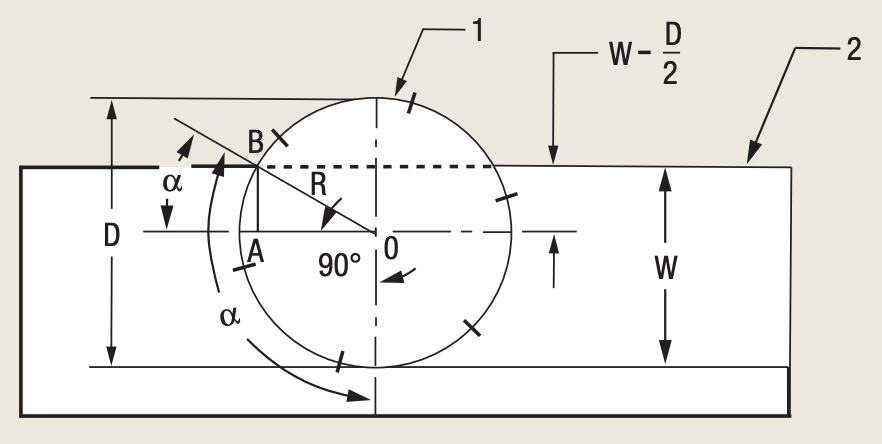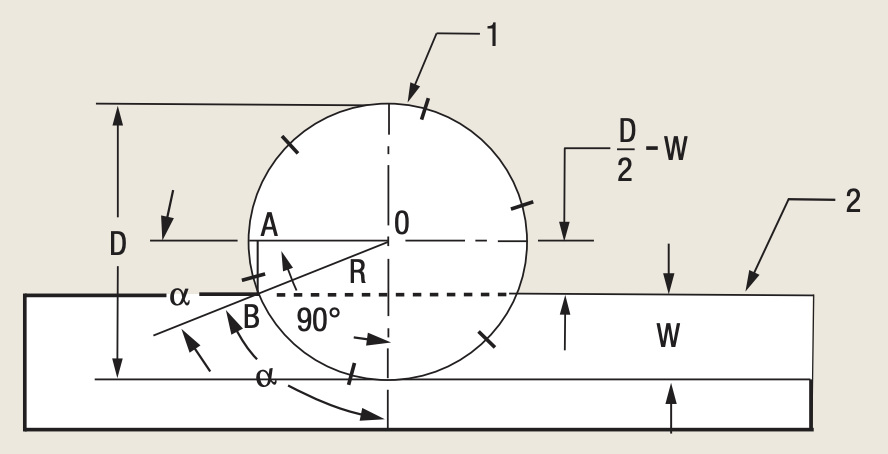 Author Edmund Isakov, Ph.D.
Author Edmund Isakov, Ph.D.
A new concept of calculating the required machining power when milling.

Courtesy of Walter
Walter’s F 4041 shoulder milling cutter.
The conventional method of calculating required machining power (Pr) is based on the metal-removal rate, measured in in.3/min. (cm3/min.), and the average unit power requirements (Pm), measured in hp/in.3/min. (kW/cm3/min.). The formula for calculating required machining power is Pr = mrr × Pm. The method has been used since the 1960s and has flaws.
For example, there is no data in the “Hardness” column between 200 HB and 35 HRC (Table 1). Because 35 HRC equals 327 HB, the gap is 127 HB. Unfortunately, the unit power data isn’t provided at the hardness from 200 to 327 HB.
In addition, Table 1 indicates the hardness number is “80 HRB” for “copper,” which is confusing. Is it a specific grade of copper? Does “copper” mean more than one grade? It’s hard to tell. There are two copper grades: C10100 and 10200 (99.99 percent Cu), whose hardness after the H80 temper is 80 HRB. The table indicates the minimal hardness of copper alloys is 10 HRB (temper H00). However, the hardness of wrought copper alloys depends on the alloying elements and their amounts and therefore varies from 25 to 100 HRB, meaning there are no wrought copper alloys with a hardness of 10 HRB.
The simplicity of this conventional method makes it popular for calculating machining power, but it is not accurate. A unit power requirement (Pm) is not really a constant value. It depends on many factors, including workpiece hardness, milling cutter geometry and the cutting parameters. As the table shows, the majority of work materials are characterized by a broad hardness range with a single average Pm value. For example, the Pm is 1.5 for the hardness range from 150 to 450 HB, which is too big of a range. It means the average unit of power requirement is not an accurate quantity. Therefore, the old method should not be used for calculating required machining power.
You can calculate the MRR with this Online Calculator
Table 1. Average Unit Power Requirements (Pm) for Milling
| Material | Hardness | Unit Power Requirements for HSS and Carbide Tools (Feed 0.005 to 0.012 ipt) |
|
|---|---|---|---|
| Sharp Tool | Dull Tool | ||
| Steels, wrought and cast: Plain carbon, alloy steels and tool steels | 85 to 200 HB | 1.1 | 1.4 |
| 35 to 40 HRC | 1.5 | 1.9 | |
| 40 to 50 HRC | 1.8 | 2.2 | |
| 50 to 55 HRC | 2.1 | 2.6 | |
| 55 to 58 HRC | 2.6 | 3.2 | |
| Cast irons: Gray, ductile and malleable | 110 to 190 HB | 0.6 | 0.8 |
| 190 to 320 HB | 1.1 | 1.4 | |
| Stainless steels, wrought and cast ferritic, austenitic and martensitic | 135 to 275 HB | 1.4 | 1.7 |
| 30 to 45 HRC | 1.5 | 1.9 | |
| Precipitation hardening stainless steels | 150 to 450 HB | 1.5 | 1.9 |
| Titanium alloys | 250 to 375 HB | 1.1 | 1.4 |
| High-temperature alloys: Nickel, cobalt and iron base | 200 to 360 HB | 2.0 | 2.5 |
| 180 to 320 HB | 1.6 | 2.0 | |
| Refractory alloys: Tungsten, molybdenum, niobium and tantalum | 321 HB | 2.9 | 3.6 |
| 229 HB | 1.6 | 2.0 | |
| 217 HB | 1.5 | 1.9 | |
| 210 HB | 2.0 | 2.5 | |
| Nickel alloys | 80 to 360 HB | 1.9 | 2.4 |
| Aluminum alloys | 30 to 150 HB (500-kg load) | 0.32 | 0.4 |
| Magnesium alloys | 40 to 90 HB (500-kg load) | 0.16 | 0.2 |
| Copper | 80 HRB | 1.0 | 1.2 |
| Copper alloys | 10 to 80 HRB | 0.64 | 0.8 |
| 80 to 100 HRB | 1.0 | 1.2 | |
The table is adapted from the Machining Data Handbook, Third Edition, Vol. 2, pg. 17-10, published in 1980 by Metcut Research Associates Inc., Cincinnati. (The First Edition was published in 1966.) “Titanium” and “Columbium” (as they appear in the original table, column Material) were renamed “Titanium alloys” and “Niobium,” respectively. Hardness abbreviations (column Hardness) were changed to present them as they are currently used: HB (Brinell hardness) replaced “Bhm”; HRC (Rockwell hardness, C scale) replaced “RC,” and HRB (Rockwell hardness, B scale) replaced “RB.”
New Calculation Method
To increase accuracy when calculating machining power, the author developed a new method based on the definition of power (P) as a product of the cutting force (F) and the cutting speed (VC):
P = F (lbs.) × VC (sfm) ÷ 33,000 (hp)
or P = F (N) × VC (m/min.) ÷ 60,000 (kW)

Figure 1. Cross sections of uncut chips produced by square and round inserts.
Because cutting speed is one of the selectable machining parameters, only the cutting force should be calculated to obtain the required machining power.
Equations for calculating the cutting force when milling can be found in various technical papers and books. However, these equations include complex trigonometric functions, integrals and matrices, and some of the formulas are second-order differential equations. Such complex equations are not appropriate in practical engineering calculations because only mathematicians proficient in calculus can execute them. Therefore, simple algebraic equations are needed to perform similar calculations within a practical range of accuracy, which is ±20 percent or better.
Simplified equations should only contain parameters that significantly impact the cutting force. These parameters are included in the new method.
An analytical study of metalcutting principles and analyses of numerous milling tests the author conducted resulted in a new concept for calculating the cutting force. The new concept is based on the relationships between the following parameters:
• Ultimate tensile strength of a workpiece vs. its hardness,
• Cross-sectional area of the uncut chip vs. axial DOC and feed per tooth,
• Number of teeth in the cut vs. number of teeth in a cutter and radial WOC,
• Engagement factor vs. radial WOC, cutter diameter and workpiece material, and
• Tool wear factor vs. axial DOC and feed per tooth.
The cutting force (F) formula is based on those relationships:
F = σ × A × ZC × CE × CW (1), where:
σ is the workpiece’s ultimate tensile strength in psi or MPa,
A is the chip’s cross-sectional area in in.2 or mm2,
ZC is the number of teeth (inserts) in the cut,
CE is the engagement factor, and
CW is the cutting tool wear factor.
Ultimate Tensile Strength
The author developed numerous statistical and linear regression formulas for calculating the ultimate tensile strength of carbon, alloy, stainless and tool steels based on their Brinell hardness numbers.
Because of space limitations, only linear regression formulas for calculating ultimate tensile strength (σ) vs. Brinell hardness number (HB) are provided for AISI 1050 carbon steel and AISI 4140 alloy steels.
AISI 1050 grade, 235 HB:
σ = 501 × HB – 568 (2)
σ = 501 × 235 – 568 = 117,167 psi
(The actual ultimate tensile strength is 117,200 psi)
Formula (2) provides 98 to 100 percent accuracy in calculating ultimate tensile strength. Its application is limited to the Brinell hardness range from 160 to 270 HB.
AISI 4140 grade, 229 HB:
σ = 506 × HB – 3,456 (3)
σ = 506 × 229 – 3,456 = 112,418 psi
(The actual ultimate tensile strength is 112,000 psi)
Formula (3) provides 97.1 to 99.9 percent accuracy in calculating ultimate tensile strength. Its application is limited to the Brinell hardness range from 195 to 580 HB.
Cross-Sectional Area
The shape of an uncut chip’s cross section depends on insert geometry and the milling cutter’s lead angle. Round inserts produce chips in the shape of a partial crescent. Inserts of all other shapes with straight cutting edges produce chips with either a rectangular cross section for milling cutters with a 0° lead angle or a parallelogram cross section for milling cutters with lead angles greater than 0°. Cross sections of the chips produced by square inserts (0° and 45° lead angles) and a round insert are shown in Figure 1.
The cross-sectional area of the chip (A) is a product of the axial DOC (d) and feed per tooth (f):
A = d × f (4)
Formula (4) is easily understood when applied to rectangular and parallelogram cross-sectional areas, but it is not so obvious when the formula is applied to a cross-sectional area of a chip produced by a round insert. Then, the cross-sectional area is either a half-crescent when the axial DOC equals the insert’s radius, or smaller than a half-crescent when the axial DOC is less than the insert’s radius. The applicability of formula (4) for crescent-like areas has been proven by integral calculus and algebraic-trigonometric calculations.
Number of Engaged Inserts
A typical facemilling cutter has three or more teeth (inserts), but only a few of them are simultaneously engaged with the workpiece. The number of inserts in a cut (ZC) depends on the number of inserts in a cutter (Z) and the engagement angle (α). This relationship is expressed by the formula:
ZC = Z × α ÷ 360 (5)
The engagement angle depends on the radial WOC (W) and cutter diameter (D). This angle is shown in Figures 2 and 3, which illustrate the two most typical positions of a milling cutter when engaged with a workpiece.
Table 2. Number of inserts in the cut vs. W:D ratio.
| W:D | 0.85 | 0.80 | 0.75 | 0.70 | 0.60 | 0.45 | 0.35 | 0.20 | 0.15 |
| ZC | 0.37 Z | 0.35 Z | 0.33 Z | 0.32 Z | 0.28 Z | 0.23 Z | 0.20 Z | 0.15 Z | 0.13 Z |
Table 3. Engagement factors vs. W:D ratio.
| Workpiece material | W:D ≤ 0.5 | 0.5 < W:D ≤ 0.7 | 0.7 < W:D = 1 |
|---|---|---|---|
| Carbon and alloy steels | 1.0 | 1.3 | 1.5 |
| Stainless and tool steels | 1.6 | 1.8 | 2.2 |

Figure 2. The centerline of the cutter (1) is located on the workpiece (2).
Figure 2 shows a cutter’s centerline on a workpiece, with the engagement angle greater than 90°. The maximum engagement angle possible is 180°, occurring when the radial WOC equals the cutter diameter. In such a case, half of the inserts are engaged with the workpiece material. If the radial WOC equals the cutter radius, only 25 percent of the inserts are engaged with the workpiece. The number of inserts in the cut can be found for any WOC using the following formulas.
As seen in Figure 2, the engagement angle (α) equals 90° plus α1, where α1 is the angle between the cutter diameter and the cutter radius R drawn to the peripheral point B at the entry or exit.
From the right-angle triangle OAB:
sin α1 = AB ÷ OB = (W – R) ÷ R = (W – D ÷ 2) ÷ (D ÷ 2) = (2W – D) ÷ D,
α1 = arc sin [(2W – D) ÷ D] and the engagement angle is:
α = 90° + arc sin [(2W – D) ÷ D] (6)
Substitution of α from formula (6) into formula (5) gives:
ZC = Z × (90° + arc sin [(2W – D) ÷ D)] ÷ 360 (7)

Figure 3. The centerline of the cutter (1) is not located on the workpiece (2).
Figure 3 shows a cutter’s centerline that is not located on a workpiece, so the radial WOC is less than the cutter radius. Therefore, the engagement angle is less than 90°.
As seen in Figure 3, the engagement angle (α) equals 90° minus α1, where α1 is the angle between the cutter’s centerline and the cutter radius R drawn to the peripheral point B at the entry or exit.
From the right-angle triangle OAB:
sin α1 = AB ÷ OB = (R – W) ÷ R = (D ÷ 2 – W) ÷ (D ÷ 2) = (D – 2W) ÷ D,
α1 = arc sin [(D – 2W) ÷ D] and the engagement angle is:
α = 90° – arc sin [(D – 2W) ÷ D] (8)
Substitution of α from formula (8) into formula (5) gives:
ZC = Z × (90° – arc sin [(D – 2W) ÷ D)] ÷ 360 (9)
If you don’t have a calculator with trigonometric functions, Table 2 helps to estimate the number of inserts in the cut based on the ratio of the radial WOC (W) to cutter diameter (D).
Engagement Factor
The engagement factor (CE) is a dimensionless quantity that depends on the ratio of the radial WOC (W) to the cutter diameter (D) and the type of workpiece.
Milling is more effective when it produces sufficiently thick and uniform chips. The W:D ratio determines chip thickness uniformity. When the radial WOC equals cutter diameter (W ÷ D = 1), the chip being formed starts at zero thickness at the point of entry and then thickness increases to its maximum at the cutter’s centerline and thins to zero at the exit point. This type of cut produces a nonuniform chip, which generates maximum friction at the cutting edge and increases cutting resistance.
Effective facemilling is obtained when W:D ≈ 2:3 or W ≈ 0.7 D. This type of cut produces uniform and sufficiently thick chips, which generates minimal friction at the cutting edge and decreases cutting resistance. Engagement factors are given in Table 3.
Wear Factor
The cutting tool wear factor (CW) is a dimensionless quantity that depends on the cutting parameters. When milling with new or freshly indexed inserts until the flank wear does not exceed about 0.004 " to 0.005 ", the cutting tool wear factor is 1.0. When milling until the inserts are indexed or replaced (the tool life reached 100 percent), the following cutting tool wear factors are recommended, according to the milling category:
• Light facemilling, CW = 1.1
• Medium facemilling, CW = 1.2
• Heavy-duty facemilling, CW = 1.3
Table 4. Milling categories and tool wear factors.
| Milling category | Axial DOC, in. | Feed per tooth, in. | Cross-sectional area of the chip, in.2 | Cutting tool wear factor, CW |
|---|---|---|---|---|
| Light | 0.020 to 0.100 | 0.003 to 0.006 | 0.00006 to 0.0006 | 1.1 |
| Medium | 0.100 to 0.200 | 0.006 to 0.010 | 0.0006 to 0.002 | 1.2 |
| Heavy duty | 0.200 to 0.400 | 0.010 to 0.020 | 0.002 to 0.008 | 1.3 |
Unfortunately, the author could not find any information that defines these milling categories and prepared a questionnaire asking for machining data that best describes the milling categories by a certain range of the axial DOC and feed per tooth. The questionnaire was sent to more than 100 people with practical knowledge and experience in milling. Statistical treatment of their responses is found in Table 4.
Required Machining Power
The following machining power calculations are performed using the conventional method and the new method to compare them.
• The work material is annealed AISI 4140 alloy steel with a Brinell hardness of 180 HB. According to Walter USA LLC’s material classification, 4140 alloy steel belongs to group 6.
• The cutting tool is Walter’s shoulder milling cutter F 4041.
Description, 4041.UB.102.Z08.13
Diameter, DC = 4.0 "
Number of inserts, Z = 8
Approach angle, κ = 90° (similar to a 0° lead angle)
Coated grade, WKP 25
• The machining data for roughing was adopted from Walter’s general catalog from 2007.
Starting value for cutting speed, VC = 850 sfm
Feed rate per tooth, fZ0 = 0.006 "
DOC, ap = 0.400 "
WOC, ae = 2.6 "
ae ÷ DC = 0.65
As previously noted, the formula for the conventional method is Pr = mrr × Pm.
• The mrr and cutter rpm:
mrr = ap × ae × fZ0 × Z × n, where n = 12 × VC ÷ (π × DC)
n = 12 × 850 ÷ (π × 4) = 812 rpm
mrr = 0.4 × 2.6 × 0.006 × 8 × 812 = 40.5 in.3/min.
• Required machining power, sharp tool (Pm = 1.1, from Table 1):
Pr = mrr × Pm = 40.5 × 1.1 = 44.5 hp
• Required machining power, dull tool (Pm = 1.4, from Table 1):
Pr = mrr × Pm = 40.5 × 1.4 = 56.7 hp
The following information is used for the new method.
• Ultimate tensile strength (σ) of AISI 4140 alloy steel, 180 HB; formula (3):
σ = 506 × HB – 3,456 = 506 × 180 – 3,456 ≈ 87,600 psi (after rounding off)
• Cross-sectional area of the chip, formula (4):
A = ap × fZ0 = 0.4 × 0.006 = 0.0024 sq. in.
• Number of inserts engaged with the workpiece, formula (7):
ZC = 8 × (90° + arc sin [(2 × 2.6 – 4) ÷ 4)] ÷ 360 = 8 × (90° + 17.46°) ÷ 360 = 2.4
• Engagement factor (CE), Table 3:
For ae ÷ DC = 0.65 and 4140 alloy steel, CE = 1.3
• Tool wear factor (CW), Table 4:
For 0.0024-sq.-in. cross-sectional area of the chip, CW = 1.3
• Cutting force, sharp tool:
F = σ × A × ZC × CE = 87,600 × 0.0024 × 2.4 × 1.3 = 656 lbs.
• Cutting force, dull tool:
F = σ × A × ZC × CE × CW = 87,600 × 0.0024 × 2.4 × 1.3 × 1.3 = 853 lbs.
• Required machining power, sharp tool:
Pr = F × VC ÷ 33,000 = 656 × 850 ÷ 33,000 = 16.9 hp
• Machining power at the motor, sharp tool:
PM = Pr ÷ η, where η is a machine efficiency factor (η = 0.8 to 0.95)
Assuming η = 0.8 (the same value as used in the conventional method):
PM = 16.9 ÷ 0.8 = 21.1 hp
• Required machining power, dull tool: Pr = 853 × 850 ÷ 33,000 = 22.0 hp
• Machining power at the motor, dull tool: PM = 22 ÷ 0.8 = 27.5 hp
The machining power values calculated using the new method:
Milling with sharp tool, PM = 21.1 hp
Milling with dull tool, PM = 27.5 hp
The machining power values calculated using the conventional method:
Milling with sharp tool, PM = 44.5 hp
Milling with dull tool, PM = 56.7 hp
This shows that the machining power calculated by the conventional method is more than twice the power calculated by the new method!
New Method Machining Power Calculator for Milling
Results:
Formula for Cutting Force (F): F = σ × A × ZC × CE × CW
Formula for Required Machining Power (Pr): Pr = F × VC ÷ 33,000
Formula for Machining Power at Motor (PM): PM = Pr ÷ η, where η is the machine efficiency factor
Cutting Tool Engineering and the author invite readers to participate in a discussion regarding these two methods of calculating the required machining power when milling. Please share your experiences and opinions. CTE
About the Author: Edmund Isakov, Ph.D., is a consultant, writer and frequent contributor to Cutting Tool Engineering. He is the author of the books “Mechanical Properties of Work Materials” (Modern Machine Shop Publications, 2000), “Engineering Formulas for Metalcutting” (Industrial Press, 2004) and “Cutting Data for Turning of Steel” (Industrial Press, 2009) and the software “Advanced Metalcutting Calculators” (Industrial Press, 2005). He can be e-mailed at [email protected] or reached at (561) 369-4063.
Related Glossary Terms
- Brinell hardness number ( HB)
Brinell hardness number ( HB)
Number related to the applied load (usually, 500 kgf and 3,000 kgf) and to the surface area of the permanent impression made by a 10mm ball indenter. The Brinell hardness number is a calculated value of the applied load (kgf) divided by the surface area of the indentation (mm2). Therefore, the unit of measure of a Brinell hardness number is kgf/mm2, but it is always omitted.
- Brinell hardness number ( HB)2
Brinell hardness number ( HB)
Number related to the applied load (usually, 500 kgf and 3,000 kgf) and to the surface area of the permanent impression made by a 10mm ball indenter. The Brinell hardness number is a calculated value of the applied load (kgf) divided by the surface area of the indentation (mm2). Therefore, the unit of measure of a Brinell hardness number is kgf/mm2, but it is always omitted.
- alloy steels
alloy steels
Steel containing specified quantities of alloying elements (other than carbon and the commonly accepted amounts of manganese, sulfur and phosphorus) added to cause changes in the metal’s mechanical and/or physical properties. Principal alloying elements are nickel, chromium, molybdenum and silicon. Some grades of alloy steels contain one or more of these elements: vanadium, boron, lead and copper.
- alloys
alloys
Substances having metallic properties and being composed of two or more chemical elements of which at least one is a metal.
- aluminum alloys
aluminum alloys
Aluminum containing specified quantities of alloying elements added to obtain the necessary mechanical and physical properties. Aluminum alloys are divided into two categories: wrought compositions and casting compositions. Some compositions may contain up to 10 alloying elements, but only one or two are the main alloying elements, such as copper, manganese, silicon, magnesium, zinc or tin.
- approach angle
approach angle
Angle between the insert’s side-cutting edge and the line perpendicular to the milling cutter’s axis of rotation. Approach angle, which is also known as cutting edge angle, is used with metric units of measurement. See lead angle.
- copper alloys
copper alloys
Copper containing specified quantities of alloying elements added to obtain the necessary mechanical and physical properties. The most common copper alloys are divided into six groups, and each group contains one of the following major alloying elements: brasses—major alloying element is zinc; phosphor bronzes—major alloying element is tin; aluminum bronzes—major alloying element is aluminum; silicon bronzes—major alloying element is silicon; copper-nickels and nickel-silvers—major alloying element is nickel; and dilute-copper or high-copper alloys, which contain small amounts of various elements such as beryllium, cadmium, chromium or iron.
- cutting force
cutting force
Engagement of a tool’s cutting edge with a workpiece generates a cutting force. Such a cutting force combines tangential, feed and radial forces, which can be measured by a dynamometer. Of the three cutting force components, tangential force is the greatest. Tangential force generates torque and accounts for more than 95 percent of the machining power. See dynamometer.
- cutting speed
cutting speed
Tangential velocity on the surface of the tool or workpiece at the cutting interface. The formula for cutting speed (sfm) is tool diameter 5 0.26 5 spindle speed (rpm). The formula for feed per tooth (fpt) is table feed (ipm)/number of flutes/spindle speed (rpm). The formula for spindle speed (rpm) is cutting speed (sfm) 5 3.82/tool diameter. The formula for table feed (ipm) is feed per tooth (ftp) 5 number of tool flutes 5 spindle speed (rpm).
- facemilling
facemilling
Form of milling that produces a flat surface generally at right angles to the rotating axis of a cutter having teeth or inserts both on its periphery and on its end face.
- feed
feed
Rate of change of position of the tool as a whole, relative to the workpiece while cutting.
- flank wear
flank wear
Reduction in clearance on the tool’s flank caused by contact with the workpiece. Ultimately causes tool failure.
- gang cutting ( milling)
gang cutting ( milling)
Machining with several cutters mounted on a single arbor, generally for simultaneous cutting.
- hardening
hardening
Process of increasing the surface hardness of a part. It is accomplished by heating a piece of steel to a temperature within or above its critical range and then cooling (or quenching) it rapidly. In any heat-treatment operation, the rate of heating is important. Heat flows from the exterior to the interior of steel at a definite rate. If the steel is heated too quickly, the outside becomes hotter than the inside and the desired uniform structure cannot be obtained. If a piece is irregular in shape, a slow heating rate is essential to prevent warping and cracking. The heavier the section, the longer the heating time must be to achieve uniform results. Even after the correct temperature has been reached, the piece should be held at the temperature for a sufficient period of time to permit its thickest section to attain a uniform temperature. See workhardening.
- hardness
hardness
Hardness is a measure of the resistance of a material to surface indentation or abrasion. There is no absolute scale for hardness. In order to express hardness quantitatively, each type of test has its own scale, which defines hardness. Indentation hardness obtained through static methods is measured by Brinell, Rockwell, Vickers and Knoop tests. Hardness without indentation is measured by a dynamic method, known as the Scleroscope test.
- high-speed steels ( HSS)
high-speed steels ( HSS)
Available in two major types: tungsten high-speed steels (designated by letter T having tungsten as the principal alloying element) and molybdenum high-speed steels (designated by letter M having molybdenum as the principal alloying element). The type T high-speed steels containing cobalt have higher wear resistance and greater red (hot) hardness, withstanding cutting temperature up to 1,100º F (590º C). The type T steels are used to fabricate metalcutting tools (milling cutters, drills, reamers and taps), woodworking tools, various types of punches and dies, ball and roller bearings. The type M steels are used for cutting tools and various types of dies.
- lead angle
lead angle
Angle between the side-cutting edge and the projected side of the tool shank or holder, which leads the cutting tool into the workpiece.
- mechanical properties
mechanical properties
Properties of a material that reveal its elastic and inelastic behavior when force is applied, thereby indicating its suitability for mechanical applications; for example, modulus of elasticity, tensile strength, elongation, hardness and fatigue limit.
- metal-removal rate
metal-removal rate
Rate at which metal is removed from an unfinished part, measured in cubic inches or cubic centimeters per minute.
- metalcutting ( material cutting)
metalcutting ( material cutting)
Any machining process used to part metal or other material or give a workpiece a new configuration. Conventionally applies to machining operations in which a cutting tool mechanically removes material in the form of chips; applies to any process in which metal or material is removed to create new shapes. See metalforming.
- milling
milling
Machining operation in which metal or other material is removed by applying power to a rotating cutter. In vertical milling, the cutting tool is mounted vertically on the spindle. In horizontal milling, the cutting tool is mounted horizontally, either directly on the spindle or on an arbor. Horizontal milling is further broken down into conventional milling, where the cutter rotates opposite the direction of feed, or “up” into the workpiece; and climb milling, where the cutter rotates in the direction of feed, or “down” into the workpiece. Milling operations include plane or surface milling, endmilling, facemilling, angle milling, form milling and profiling.
- milling cutter
milling cutter
Loosely, any milling tool. Horizontal cutters take the form of plain milling cutters, plain spiral-tooth cutters, helical cutters, side-milling cutters, staggered-tooth side-milling cutters, facemilling cutters, angular cutters, double-angle cutters, convex and concave form-milling cutters, straddle-sprocket cutters, spur-gear cutters, corner-rounding cutters and slitting saws. Vertical cutters use shank-mounted cutting tools, including endmills, T-slot cutters, Woodruff keyseat cutters and dovetail cutters; these may also be used on horizontal mills. See milling.
- stainless steels
stainless steels
Stainless steels possess high strength, heat resistance, excellent workability and erosion resistance. Four general classes have been developed to cover a range of mechanical and physical properties for particular applications. The four classes are: the austenitic types of the chromium-nickel-manganese 200 series and the chromium-nickel 300 series; the martensitic types of the chromium, hardenable 400 series; the chromium, nonhardenable 400-series ferritic types; and the precipitation-hardening type of chromium-nickel alloys with additional elements that are hardenable by solution treating and aging.
- tensile strength
tensile strength
In tensile testing, the ratio of maximum load to original cross-sectional area. Also called ultimate strength. Compare with yield strength.
- tool steels
tool steels
Group of alloy steels which, after proper heat treatment, provide the combination of properties required for cutting tool and die applications. The American Iron and Steel Institute divides tool steels into six major categories: water hardening, shock resisting, cold work, hot work, special purpose and high speed.
- turning
turning
Workpiece is held in a chuck, mounted on a face plate or secured between centers and rotated while a cutting tool, normally a single-point tool, is fed into it along its periphery or across its end or face. Takes the form of straight turning (cutting along the periphery of the workpiece); taper turning (creating a taper); step turning (turning different-size diameters on the same work); chamfering (beveling an edge or shoulder); facing (cutting on an end); turning threads (usually external but can be internal); roughing (high-volume metal removal); and finishing (final light cuts). Performed on lathes, turning centers, chucking machines, automatic screw machines and similar machines.








